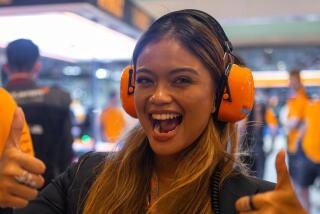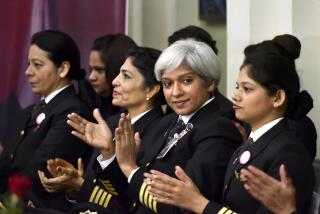Women, Go Ahead and Ride in the Biker Lane
- Share via
It may seem a strange habit, but whenever I come across another motorcyclist, I check to see if there is a braid or ponytail hanging from the helmet. That isn’t the most accurate indicator that a woman is at the controls, but it’s easier than trying to make out a figure under leather.
(Few of us share Uma Thurman’s dimensions. And even if we did, we probably wouldn’t wear a cat suit.)
I’m always looking for other women who ride. Unfortunately, I rarely find them.
Why do I wish more women would get on bikes? Because riding is fun (“I can actually feel the centripetal force!”), sensory (“That jasmine tree is not only pretty--I can smell it, too!”), empowering (“This is way better than being a passenger. I can actually see!”) and not enough women do it (only 8% of motorcyclists are female, according to the Irvine-based Motorcycle Industry Council).
The reasons more women don’t are pretty standard: Riding can be intimidating (“You mean I have to use both feet and both hands?”), scary (“I could die!”) and incredibly unladylike to straddle what is essentially an exposed automobile engine (“What if I want to wear a skirt and heels?”).
At least those were my excuses, which is why I went scooter shopping first. I’m happy I changed my mind and bought a bike.
What won me over was the argument that motorcycles are safer than scooters. When I learned that what could get me into trouble--power--was the exact same thing that could get me out of it, I was sold.
When I talk with other women about why they ride, many of them say they made the choice because motorcycles are cheap and easy transportation.
They keep riding because it’s fun.
Here’s another reason to consider: Driving your own bike is safer than riding as a passenger on the back. According to a 1998 U.S. Department of Transportation Fatality Analysis Report, women account for 10% of all motorcycle fatalities. But more than three-quarters of the women who died were passengers.
Also, women are generally safer riders. A higher percentage of women than men take a class to learn how to ride properly. Studies show that the majority of riders who’ve had accidents were taught by friends. And while women constitute only a tiny portion of motorcycle riders, more than a third of students who graduate from the Motorcycle Safety Foundation’s street skills course are female.
Female riders tend to ride more cautiously than men. They also have better eye-hand coordination and small-muscle control, which makes for quicker reaction times.
Riding isn’t for everyone, I know, but those with an interest usually don’t pursue it right away because they don’t know how. Whether it’s for lack of money or an abundance of fear, getting started is the hardest part. Both problems can be overcome.
Good, used bikes can be found for less than $1,000. And classes for beginners are widely available through the California Motorcyclist Safety Program, founded in 1987 by the California Highway Patrol. Classes range in price but, on average, cost about $180. Riders under 21 pay only $75. (Information: [800] 227-4337.)
Keep in mind that the price doesn’t include any assurance that you’ll be the next Ann-Margret. Becoming a good rider is an evolution. It takes practice, usually in a parking lot or on uncrowded streets during low traffic times.
So if you decide to ride, be safe. And be happy for that helmet law. That way no one can see who you are when you make a mistake.
More to Read
Sign up for The Wild
We’ll help you find the best places to hike, bike and run, as well as the perfect silent spots for meditation and yoga.
You may occasionally receive promotional content from the Los Angeles Times.






